Introduction
Artist’s conk (Ganoderma applanatum), also referred to as artist’s bracket, red mother fungus, Ancient Ling Zhi, and bear bread fungus, is a bracket fungus that infects a bevy of trees. In Japan, the fungus is known as kofuki-saru-no-koshikake, which translates to “powder covered monkey’s bench.” It is called shu-she-ling-zhi in China. Artist’s conk is a polypore: it achieves sporulation through pores instead of gills. The fungus has an ascending, shelf-like appearance that distinguishes it from other polypores. Artist’s conk is initially parasitic. Once the host expires, the fungus becomes a saprotroph, decaying the remaining organic tissue.
Distribution & Habitat
Artist’s conk occurs globally, wherever susceptible trees are present.
Hosts
Artist’s conk infects most hardwoods, and many conifers. It is most common on alder, ash, beech, Douglas-fir, elm, poplar, buckeye chestnut, horse chestnut, maple, walnut, willow, western hemlock, olive tree, and spruce. Older trees and trees suffering from environmental stressors are more susceptible to infection.
Disease Cycle
The fungal spores infiltrate trees through bark injuries, branch stubs, and other wounds. Fruiting bodies form on the trunks of infected trees. When they first appear, the fruiting bodies are white. As they mature, the fruiting bodies turn a dark reddish-brown. The fruiting bodies are fan to hoof shaped, with a hard exterior. They are perennial, and may persist for years, increasing in size, and forming new layers as they develop.
Artist’s conk causes a white to yellow rot of the sapwood and heartwood. Over time, the decay will become extensive, rendering the tree prone to failure. Sporulation typically occurs in spring and fall, when conditions are sufficiently moist. The spores are dispersed by air currents, splashes of rain, or insect vectors to nearby trees, which they readily infect. If conditions are favorable, infections can be induced all year.
Symptoms of Infection
The fruiting bodies are conspicuous on infected trees. They can measures 12 to 40 inches in diameter, and may be observed on infected tree trunks and stumps. When plucked from infected trees, the fruiting bodies will reveal layers of pores that resemble rings.
Uses
The fruiting bodies are inedible in their raw form. However, when cooked, they have a rich mushroom flavor that blends well with various recipes. Slices of the fruiting bodies have been used in fermented foods to enhance their flavor. When dried and ground, the fruiting bodies can be made into a tea or tincture. Artist’s conk can be used for dyeing wool, certain fabrics, and paper. In Asia, the fruiting bodies are blended or cold pressed with water to create ganoderma drinks.
Artist’s conk contains antibacterial compounds. As such, it is often used in traditional medicines. If rubbed or scratched with a pointed utensil, artist’s conk bruises. The bruises become permanent once the fungus has dried. This makes the fungus an ideal platform for artists to paint or sketch intricate designs on. The midge Agathomyia wankowiczii lays its eggs on the fruiting bodies. The forked fungus beetle, Bolitotherus cornutus, dwells within the fruiting bodies for its entire life cycle.
Management
- Maintain trees through sound cultural practices. Ensures that trees are sufficiently watered. Each year, apply fresh organic mulch around the base of trees. Proper mulching will help to improve the soil quality, moderate the soil temperature, and retain soil moisture.
- Avoid mechanical injuries to potential hosts.
- Prune broken or damaged branches. Provide maintenance to trees that are overgrown. Periodically thin out tree canopies to increase air circulation, and promote a rapid drying of the foliage.
- Culling infected trees may prevent the fungus from spreading, and achieve some control.


